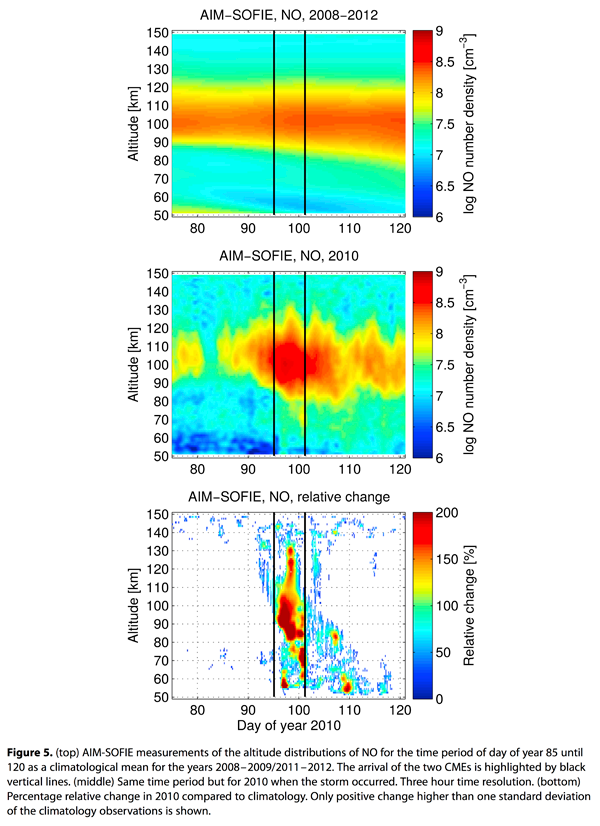|
STATUS:
01.26.2018
Instrument Status:
The spacecraft continues to perform nominally.
SOFIE
SOFIE resumed science measurements on November 21, 2017, when the AIM orbit beta angle became low enough (below ~67 degrees) to enable solar occultation to be viewed from orbit. These observations are in the Northern winter and feature nearly co-located sunrise and sunset measurements, that will be used in investigations of the mesospheric vortex. SOFIE science and housekeeping parameters all indicate a stable and healthy instrument. SOFIE V1.3 data are available online through February 2017.
Smith-Johnsen et al. [2017] recently investigated the impact of electron precipitation on nitric oxide (NO) in the middle atmosphere using SOFIE measurements. In April 2010, a coronal mass ejection (CME) and a co-rotating interaction region on the Sun resulted in an energetic electron precipitation event in the Earth’s atmosphere. They investigated direct and indirect NO response to the electron precipitation. Combining electron fluxes from the Total Energy Detector and the Medium Energy Proton and Electron Detector on the National Oceanic and Atmospheric Administration’s Polar-orbiting Operational Environmental Satellites, gave a continuous energy spectrum covering 1–750 keV. This corresponds to electrons depositing their energy at atmospheric altitudes 60–120 km. Based on the electron energy deposition, taking into account loss due to photolysis, the accumulated NO number density is estimated. When compared to NO measured at these altitudes by SOFIE, the NO direct effect was detected down to 55 km. The figure below illustrates the observed NO enhancement (Figure 5 from Smith-Johnsen et al., 2017). The main variability at these altitudes is, however, dominated by the indirect effect, which is downward transported NO. The source of this descending NO was estimated to be in the upper mesosphere at ∼75 – 90 km.
Smith-Johnsen, C., H. Nesse Tyssøy, K. Hendrickx, Y. Orsolini, G. Kishore Kumar, L.-K. G. Ødegaard, M. I. Sandanger, F. Stordal, and L. Megner (2017), Direct and indirect electron precipitation effect on nitric oxide in the polar middle atmosphere, using a full-range energy spectrum, J. Geophys. Res. Space Physics, 122, 8679–8693, doi:10.1002/2017JA024364.

|
